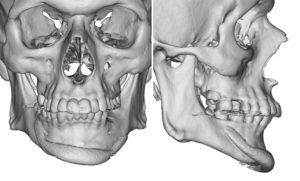Contemporary chin implants, often called anatomic chin implants, have extended wings of material that go back along the jawline. This change in the shape of chin implant was done decades ago to overcome the aesthetic shortcomings of the old style button chin implants which often looked like a round circle sitting on the front end of the chin.
While these extended wings on the chin implant have their aesthetic value, they also create other potential problems. Should the chin implant end up having a tilt to its alignment along the lower edge of the bone, the chin will develop asymmetry. While such chin asymmetry is an aesthetic complication, the more significant complication can come from mental nerve compression.
If the wing of the chin implant from an asymmetrical placement or shift of the implant gets close to the exit of the mental nerve, nerve impingement symptoms may develop. These can include numbness of the nerve’s distribution (lip and chin) but, more importantly, pain. The pain can be constant or can mainly occur only pressing on the nerve area. While some temporary numbness can occur from any chin implant procedure, it is the symptom of pain that alerts to the possibility of mental nerve compression.

If a chin implant wing is compressing against the mental nerve, the sooner it is relieved by implant repositioning the better. Prolonged compression can cause axonal death and result in permanent nerve injury.
Dr. Barry Eppley
Indianapolis, Indiana


